|
Travelogues Bollywood: Dream Capital
|
|||||||||||||||
The wag who thought of combining Bombay and Hollywood and came up with "Bollywood" as a name for Bombay, in jestful recognition of the city's prolific film output, will have to get busy again. For some considerable time, the city has reverted to its original name of Mumbai. It is the capital of the state of Maharashtra, on the West Coast of India.
It is a city full of contrasts. As a city it is so wealthy, it is said to pay 50% of the entire nation's income tax. At the same time, it houses some of the worst slums in the country. Palatial mansions stand cheek-by-jowl with ramshackle tenements. Air-conditioned cars, rickety rickshaws, overloaded trucks and wobbling cyclists try to avoid the same potholes or cows in the road at the same time. |
More on Maharashtra •Forts of Maharashta
Travelogues
Impressions | ||||||||||||||
The exhaust fumes from all this vehicular traffic, during peak hours (5 a.m. to midnight),
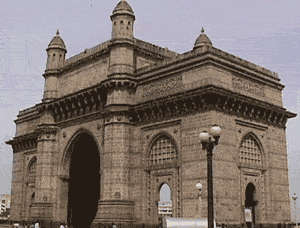 are so foul that they give "pollution" a bad name. There have been instances of delays to flights because of the smog reducing the visibility below safe limits. Under these circumstances, one would imagine that people would want to get away from the city, rather than crowd into it. But they keep streaming in; with pockets full of nothing and minds full of dreams, at the rate of an estimated 350 families every day (current population 9,926,000)! The reason for the fatal attraction is quite simple. One can always find some way of making a living here. It may not be much of a life, but it is better than what was available in the immigrant's native place. are so foul that they give "pollution" a bad name. There have been instances of delays to flights because of the smog reducing the visibility below safe limits. Under these circumstances, one would imagine that people would want to get away from the city, rather than crowd into it. But they keep streaming in; with pockets full of nothing and minds full of dreams, at the rate of an estimated 350 families every day (current population 9,926,000)! The reason for the fatal attraction is quite simple. One can always find some way of making a living here. It may not be much of a life, but it is better than what was available in the immigrant's native place.
It is also the reason for the continuous proliferation of innumerable slums. Mumbai is not bursting at the seams any more. That happened long ago. Now it is spilling into the sea and onto mainland India. To alleviate this space problem, every kind of effort is being made; including the establishment of a twin city called New Mumbai. But, alas, to little avail. The new city is getting as crowded as the original one. The main reason is its strategic location. It is a very safe port. It's two main railway termini, viz. Chhatrapati Shivaji Terminus (previously Victoria Terminus) and Mumbai Central, connect to all parts of India. The airport is served by a host of major international and Indian domestic airlines. Road connections to all parts of India are improving all the time. The original occupation of the city was fishing.
A shining example of these qualities is the Tata family, the most famous Parsi family. Over the centuries, the Parsis have become an integral part of Mumbai. People, who enjoy the various 'Dhansak' dishes in the Indian Restaurants, have the Parsis to thank for them. A few years ago, another Iranian community in Mumbai was very prominent. Called Iranis, they too had become an integral part of Mumbai. Their speciality was running street corner restaurants and bakeries that they used to keep open late at night. Many a Mumbaikar (a native of Mumbai) used to go to these places for a late night cuppa and a plate of "Muska-Slice" (buttered slice of bread) or "Bun-Muska" (buttered bun). Another dish these Irani restaurants were justifiably renowned for was omelettes. Also, ordering a cake was an unforgettable experience. On receipt of your order, the waiter would wheel out a whole trolley load (a dietician's nightmare) for you to chose from. If the eye-catching icing did not take your wicket, a single bite of the merchandise, most certainly, did! If you could restrict yourself to just one piece, all I can say is "You are a better man than I Ganga Din!" On my recent visit to Mumbai, for some reason, there were not any of these restaurants in evidence. I, for one, will miss them. Despite the presence of various religious communities, there is very little friction between them, as a rule. What strife there is, is usually, only between the Hindus and the Muslims. It is believed that these disturbances are instigated, either by politicians or goondas (gangsters) to further their own interests
The dubbawalla arrives at the appointed time, collects the dubba and through a relay system, ensures that the right person gets the right dubba. After lunchtime the whole process is reversed and the dubba arrives back at the starting point. The only identification marks on these dubbas are some coded scribbles put there by the dubba-walla organisation. Since there are literally, hundreds and thousands of dubbas being transported every day, to and fro, how the right dubbas reach their rightful owners in the workplaces and back again to the right homes, is nothing short of astounding. On the local trains, these dubba-wallas have specially reserved compartments for safe transportation of this valuable cargo. An organisation similar to this does not exist anywhere else in India or the world.
This then, is the film capital of the world. Most of the films are referred to, somewhat derogatively, as masaala films. Meaning, there is a standard recipe, like that for a curry (masaala is a mixture of various spices). Typically, there is a Hero. He is not only a Jack of all Trades; he is a Master of them all. He can dance the Bhangra and the Waltz, with equal aplomb. He can ride a motorcycle at 80 miles per hour, while holding a baby in one hand. And if the Heroine gets into difficulties in mountainous seas, he is the only lad who can jump in to save her! Then, there is the Heroine. She is all fluttering eyelashes, coy looks, is always immaculately dressed and never less than voluptuous in appearance. She is forever ready to be chased by the Hero, through beautiful gardens, snow-laden slopes, beaches with rolling surf and whatever else one can think of. One of the two has to be filthy rich and the other one dirt poor, preferably a slum-dweller. Then there is the villain, who naturally, has evil designs on the heroine and vile plans for the hero. Additionally there is, almost always, resistance from either the hero's or the heroine's family for their marriage. The end of each movie begins with a hair raising car chase, followed by a showdown between the hero and the villain, while the heroine's fate hangs in the balance. At first the hero gets the living daylights smashed out of him. But one coy look from the heroine does the trick! He recovers and vanquishes the villain. And in the end, they walk away into the sunset to live Happily Ever After. Then there is the Vamp. Her principal role is to try and lure the hero away from the heroine, by indulging in extremely provocative singing and dancing. Believe it or not, this masaala has been in use for more than 50 years, and is pulling in the crowds even today! Over the years, some unforgettable films have also been made. The industry has produced talent in every field of filmmaking that will rank among the very best. I will mention just a few of them. One hero, who started his career more than 50 years ago and who never once, gave a less than excellent performance is Ashok Kumar. Over the years his cumulative audience would easily exceed a few billion. He is known as the evergreen hero.On the way, he has had extremely tough competition from Dilip Kumar, Raj Kapoor and Dev Anand. These four have carved out a niche and they will be indelible from peoples' memories. As for the villains, two names stand out, Pran and K.N.Singh. They only had to raise an eyebrow, or display a fleeting grin in the corner of the mouth to signal their evil intentions. Both suffered the actors' nightmare of being permanently typecast as villains, but I doubt they shed any tears on their way to the bank. On the heroine front, we have had great names like Meena Kumari, Madhubala, Nutan, Waheeda Rehman, Vaijayantimala, and Nargis to name just a few. They all had two things in common. They were very, very beautiful, with talent to match. Another institution is possibly unique to Indian cinema - that of the Playback Singers. The songs that these singers sang, were set to tunes by such musical geniuses as Naushad, S.D. Burman, Shankar (&) Jaikishen, O.P.Nayyar, C. Ramchandra, Hemant Kumar and many others. An overview of Mumbai's film megastars will be incomplete without a special reference to Kishore Kumar. He really, was a Master of all Trades. He was an actor, comedian, playback singer, music director, film director, and producer and did it all commendably well. He introduced yodelling to Indian singing and made it appear as if it had been a part of Indian music, all along. He was the absolute master of the art of voice acrobatics. As for the Vamp, one name stands up head and shoulders above all others, HELEN. In that role she reached the pinnacle. Any ordinary mortal, trying out the gyrations she used to perform as easily as walking, would end up in an orthopaedic ward. Sex appeal used to drip out of her persona, like honey from a saturated beehive. I have never seen anyone looking so devastatingly sexy. One has to merely mention her song (from the film "Howrah Bridge", sung by Geeta Dutt) "Mera Naam Chin Chin Choo", and everybody from my generation, men and women alike, will start humming the tune and tapping their feet! Such was her appeal to the public, that producers used to insist on including a song and dance routine by Helen, irrespective of whether the plot demanded it or not. As mentioned earlier, there is a congregation of a variety of religions in Mumbai. But for the true blue Mumbaikar, there is only one religion ......CRICKET! There is not one open space in Mumbai, where cricket has not been played. Roads, pavements, alleyways, even balconies of tenement buildings are not exempt from this. The original Test Match ground was the Brabourne Stadium, where I saw my first test match in 1956 (India V Australia). For the last 25 odd years, it has been the Wankhede Stadium. Additionally, there are grounds like the Azad Maidan, the Cross Maidan (Maidan is a ground), the Hindu Gymkhana, the Parsee Gymkhana, Shivaji Park; the list is endless. Incidentally, Shivaji Park is where two of India's most idolised cricketers learned and honed their craft, along with a host of others. They are Sunil Gavaskar and Sachin Tendulkar. The enthusiasm for this game, shown by the Mumbaikars, borders on obsession. Let alone test matches or one-day internationals, even inter-school games attract big crowds. People ridicule the English for inventing a game, which is basically a fair weather game, in a country not renowned for fair weather, especially in summer. We Mumbaikars go one better. Some of our tournaments start in the monsoon season! There is, and always has been, so much cricketing talent in this one city, that Mumbai on its own can field a team that could successfully represent India, with honours, against any opposition. To say to a Mumbaikar that he does not know much about cricket is equivalent to saying to an Englishman that he can't make tea. It is the ultimate insult! Any other seaside city, fortunate enough to enjoy People going on holiday, always make sure that they avoid the rainy season. But in Mumbai we get a throng of visitors, with the express desire to see the torrential monsoon rain. Visitors come from the Middle East, where rain is such a rarity. In that respect, Mumbai scores over London, on two points, viz. the rain is guaranteed and it never gets cold. Mumbai may not have a Taj Mahal or magnificent castles or erotic temples to view and admire, like some places in India. To some people it may be merely a capital city, creating celluloid dreams. Others may dream of coming here to make a better life for themselves. We Mumbaikars are happy that it is the cricket capital of India. After all, we do take our religion seriously! As a matter of fact, Mumbai does have a Taj Mahal. But it is a world famous Five star hotel!
|
|||||||||||||||
Editor: Romola Butalia (c) India Travelogue. Alsl rights reserved. |
|||||||||||||||

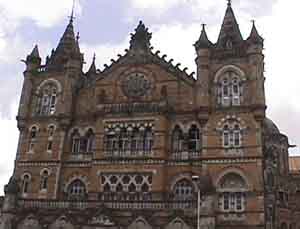 But, since its passage as a dowry from the Portuguese to the English King Charles II, on his wedding to Catherine of Braganza, Mumbai started coming into its own. It is now difficult to realise that it was just a small fishing village, comprised of 7 little islands. Today, only the names of those islands, such as Dadar, Colaba, Sion and Mahim remain. The British built it into an administrative and military base. The Fort area of South Mumbai is full of buildings of British design that reflect the opulence of the Raj. The buildings which house the Mumbai Municipal Corporation, CST, The Times of India Office and Mumbai Central Station resemble the City of London in terms of architecture if nothing else. The crowds and the noise are another story. The development of Mumbai into a Megapolis began with the opening of the first Indian railway, in 1853, between Victoria Terminus (now CST) and Thane.
But, since its passage as a dowry from the Portuguese to the English King Charles II, on his wedding to Catherine of Braganza, Mumbai started coming into its own. It is now difficult to realise that it was just a small fishing village, comprised of 7 little islands. Today, only the names of those islands, such as Dadar, Colaba, Sion and Mahim remain. The British built it into an administrative and military base. The Fort area of South Mumbai is full of buildings of British design that reflect the opulence of the Raj. The buildings which house the Mumbai Municipal Corporation, CST, The Times of India Office and Mumbai Central Station resemble the City of London in terms of architecture if nothing else. The crowds and the noise are another story. The development of Mumbai into a Megapolis began with the opening of the first Indian railway, in 1853, between Victoria Terminus (now CST) and Thane.
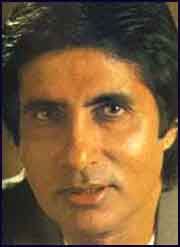 It has overtaken Hollywood in number of films produced annually. Today, in spite of the wide availability of television, and a vast number of channels to pick from, the annual film production of Mumbai, surpasses that of any other place in the world. Not that each one is a box-office hit, nor does every film in production reach the silver screen. But these films serve a dual purpose. In addition to entertainment, in the fierce heat of the Mumbai summer, the theatre provides a haven where one can take the weight off one's feet, in cool surroundings for 3 hours. Yes, Indian films do last for 3 hours.
It has overtaken Hollywood in number of films produced annually. Today, in spite of the wide availability of television, and a vast number of channels to pick from, the annual film production of Mumbai, surpasses that of any other place in the world. Not that each one is a box-office hit, nor does every film in production reach the silver screen. But these films serve a dual purpose. In addition to entertainment, in the fierce heat of the Mumbai summer, the theatre provides a haven where one can take the weight off one's feet, in cool surroundings for 3 hours. Yes, Indian films do last for 3 hours.
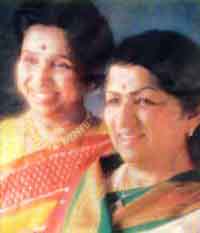 They provided the voices to the heroes and heroines' songs on the screen. Often it was their singing that saved films from crashing at the box-office. Male singers who achieved idol status for my generation include Mohamed Rafi, Mukesh, Manna Dey, Talat Mehmood, Kishore Kumar (Ashok Kumar's younger brother), Hemant Kumar etc. On the female side, the two sisters, Lata Mangeshkar and Asha Bhonsle, have exceeded even the idol status. They can only be described as undisputed queens of playback singing. Lata Mangeshkar, Asha Bhonsle and Mohamed Rafi are in the Guinness Book of Records as the Most Recorded Artistes in the World. They have recorded over 25,000 songs, each!
They provided the voices to the heroes and heroines' songs on the screen. Often it was their singing that saved films from crashing at the box-office. Male singers who achieved idol status for my generation include Mohamed Rafi, Mukesh, Manna Dey, Talat Mehmood, Kishore Kumar (Ashok Kumar's younger brother), Hemant Kumar etc. On the female side, the two sisters, Lata Mangeshkar and Asha Bhonsle, have exceeded even the idol status. They can only be described as undisputed queens of playback singing. Lata Mangeshkar, Asha Bhonsle and Mohamed Rafi are in the Guinness Book of Records as the Most Recorded Artistes in the World. They have recorded over 25,000 songs, each!
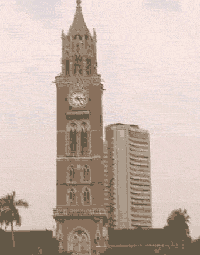 the daily sunshine and temperatures of Mumbai, will have its beaches packed with swimmers and sunbathers. Mumbaikars don't indulge in those pastimes on account of two things, (i) The sea around Mumbai is badly polluted with untreated sewage and (ii) all Mumbaikars are born with an ample suntan! Most Mumbaikars restrict their seaside activity to strolling on the beach in the evening and sampling Bhelpuri. For any visitor to this city, it is an absolute must to try a plate of this delicacy, on the beach, not in a hotel or a restaurant. It is a tradition like strawberries and cream is at Wimbledon. The only difference being that here the prices are down to earth. Bhel is a mixture of several savoury things, topped with a tamarind sauce. The resulting fire on the tongue can be put out with fresh coconut water. The coconut is skinned and pierced in front of the customer. After draining all the water, you can finish off the tender copra inside as a dessert. Mumbai is renowned for crabs, prawns and fish like Pomphret or the world famous Bombay Duck. It is a complete mystery as to how a salt-water fish came to be called a duck. But over the years, it has provided the Masters of numerous quiz programmes, a good trick question.
the daily sunshine and temperatures of Mumbai, will have its beaches packed with swimmers and sunbathers. Mumbaikars don't indulge in those pastimes on account of two things, (i) The sea around Mumbai is badly polluted with untreated sewage and (ii) all Mumbaikars are born with an ample suntan! Most Mumbaikars restrict their seaside activity to strolling on the beach in the evening and sampling Bhelpuri. For any visitor to this city, it is an absolute must to try a plate of this delicacy, on the beach, not in a hotel or a restaurant. It is a tradition like strawberries and cream is at Wimbledon. The only difference being that here the prices are down to earth. Bhel is a mixture of several savoury things, topped with a tamarind sauce. The resulting fire on the tongue can be put out with fresh coconut water. The coconut is skinned and pierced in front of the customer. After draining all the water, you can finish off the tender copra inside as a dessert. Mumbai is renowned for crabs, prawns and fish like Pomphret or the world famous Bombay Duck. It is a complete mystery as to how a salt-water fish came to be called a duck. But over the years, it has provided the Masters of numerous quiz programmes, a good trick question.